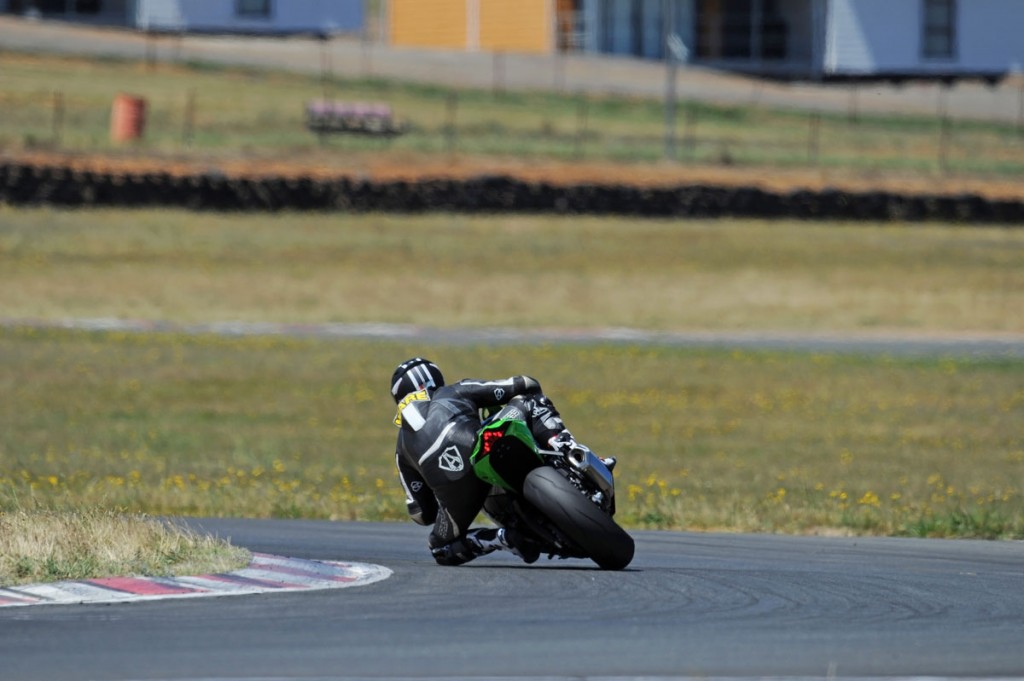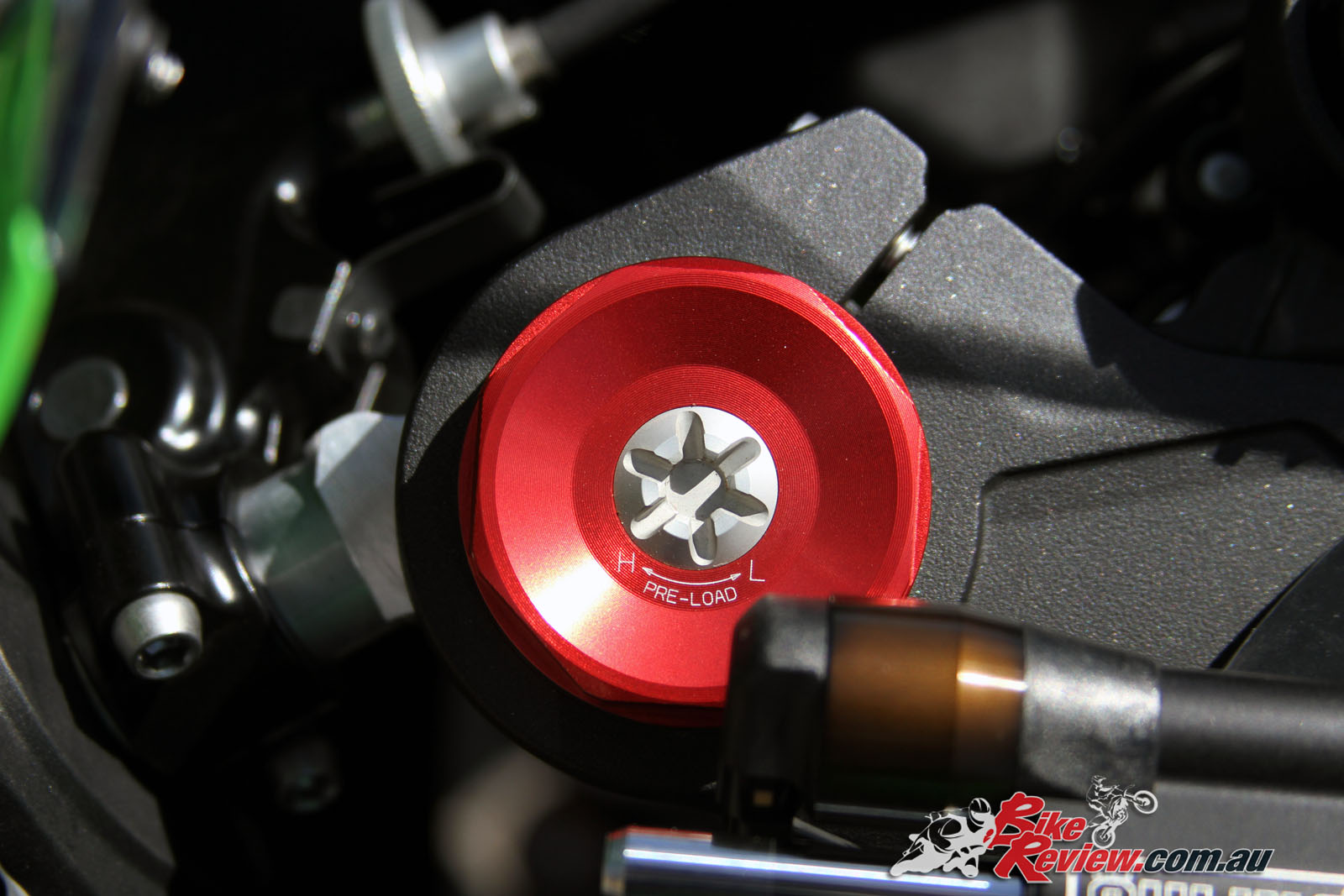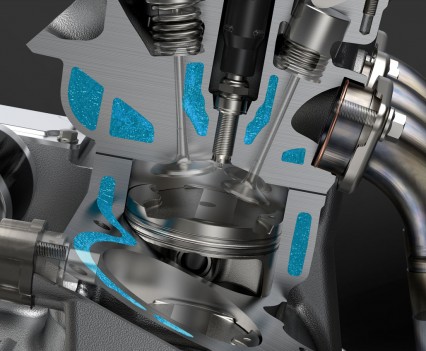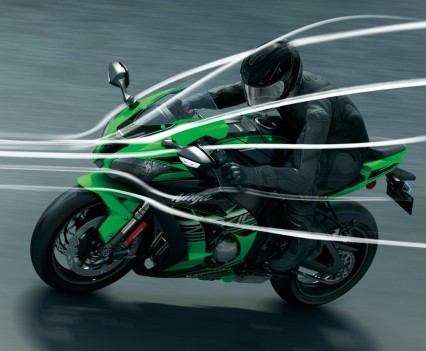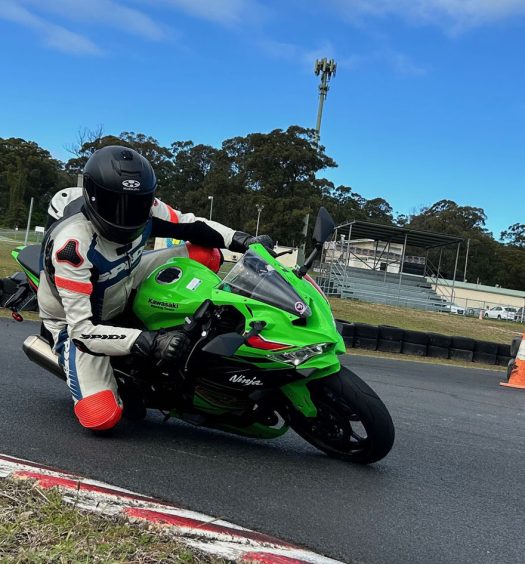Review: 2016 Kawasaki Ninja ZX-10R World Track Launch
The new ZX-10R is all that Rea and Sykes promised us, plus some... Here's our 2016 Kawasaki Ninja ZX-10R world launch track review from Wakefield Park. Test by Jeff Ware, Kris Hodgson Photography by Keith Muir
I’ve just sat down after a day cutting around 40 laps on the new 2016 Kawasaki ZX-10R at a world exclusive first test and I’m still trying to come to terms with just how good the bike is and why. I expected improvements. What I experienced was stunning.
You can learn all about the new machine by reading our comprehensive technical breakouts, however, in short Kawasaki said to themselves, “Bugger all the cosmetic and marketing related fashion crap, let’s just make this beast lap faster, easier, than anything else anyone can buy. If a part doesn’t improve lap times, it’s straight in the bin”.
Project leader Yoshimoto Matsuda sums it up after his technical chat, “When you climb a mountain, you don’t carry a big bag of nice clothes and fine food. You won’t get to the top carrying that rubbish”.
The enthusiasm on Matsuda-Sans face says it all as he explains how hard the Team Green engineers and test riders have worked and, most importantly, how much they have used the invaluable feedback from Tom and JR, both Kawasaki #1 plate holders.
Despite the denial of appearance counting for anything, as I walk around the bike, I do start to fall for it, so Kawasaki have tapped into the feelings of fans like me. The KRT livery on my test bike looks hot and makes me feel even more like Tom Sykes than my beard, specially grown for today, does.
The tail unit looks sharper and that ugly muffler is gone, replaced with a neat Ti unit. The reshaped upper cowl looks like the SBK fairing and the dash is at least bigger than an iPhone, unlike another litre-class bike’s tiny clocks.
As I familiarise myself on the bike the ergonomics feel fantastic but I would like the ‘pegs around 5mm lower. However, after touching the ‘pegs down already, I realise this would be an issue.
I like it. It looks fast and has no crap hanging off it…So what was it like to ride? In a word, rewarding.
I’ve done over 2000 laps of this track, so it was straight to the task at hand – pushing the 10R to the limits…
Aside from that I feel comfy and familiar as I warm up. The new ‘bar position puts me over the front a little more and I feel confident in the front end, which I need or there is no way I can push hard. Down the chute, tucked in, the larger frontal area completely isolates me from the airflow. It’s fantastic and I am a bigger build at 90kg plus 185cm. Aside from these things, the bike ‘feels’ like the previous one to be on. But what about the performance?
As I approach the fast right kink at the end of the short straight, I brake hard for the first time, trying to feel for the limit of the SC1 front tyre fitted. I find the limit easily and with finesse. The feel and feedback from the forks and Brembo package is the most refined I have felt on any production bike and only matched by the factory superbikes I have tested. This braking area is a kink that is off camber and of tightening radius and the 10R eats it up. Stunning.
Braking hard while turning in and shifting down gears here was always hard on the previous model, which had to be wrestled onto its side using my outer arm forearm and knee usually, then lots of pressure to keep it over before firing off the turn feeding power in gently.
Right now my arms are relaxed, I’m stopping the bike 20 per cent harder, it is heading to the apex where I am looking, basically on its own, completely stable thanks to the brake assist and closer gear ratios making rpm changes less on downshifts.
The 10R is tracking through the turn with no stand-up and the next thing I’m exiting on full 100 per cent throttle, driving hard up a long right-hand uphill turn, while the 10R wheelspins ever so slightly and the front wheel hovers an inch off the ground maximum as the electronics keep me out of hospital. It is stunning to experience and easy to trust. Check our on board video!
Repeating this process corner after corner means I end up lapping only a few seconds off my normal time here on a slick-shod 1000cc production based superbike. I’m impressed and I feel like I can keep going all day, not even raising a sweat. This has to be the easiest superbike class machine to ride fast that I’ve ever experienced…
As I head downhill and into the fast left dogleg a few more laps in, I push that little bit harder and find myself running too deep. I repeat this a few times. No problem. For the next session I adjust the Engine Brake Assist and try that. Nope. I come in and switch it off and am immediately on line into that turn.
This time I am better off with it off but the options are there for various conditions. In the end I settle for FULL Power, S-KTRC 1, KEBC OFF. I try S-KTRC on all 5 settings including OFF and prefer 1, the least intrusive, to keep the wheels inline. This test machine is non-ABS equipped.
Reeling off lap after lap I focus on individual points that have been revised. The fork action is like nothing I have experienced. Silky smooth over high and low speed bumps, soft and subtle yet loads of support on hard braking, even sudden sharp hard braking. The brake feel is so intimate and although the same spec as the Ducati Panigale 1299, the ZX-10R package feels more intuitive when it comes to small lever modulations, particularly braking on the side of the tyre.
Out the back, the rear suspension again offers fantastic support and stability on hard acceleration and into turns. There is abundant feel from the rear tyre and the bike is not pitchy at all but I would prefer a more one-to-one connection between the throttle and the rear tyre. Braking hard into turns I feel I am sitting in the bike not on top of it, which I like, something I have struggled with on other new models, where I end up with arm pump. I find many new sportsbikes to tall in the seat and low in the ‘bars. On the 10R, my arms are not even getting used much at all.
The engine is the heart of any motorcycle and as technology increases, soul does tend to get tuned out in favour of practical delivery. This is the case with the ZX-10R. If, like me, you like cutting fast laps, then you will appreciate this engine as it allows lots of early throttle roll. If you like a big stupid grin on your face after a triple-clamp pops up and smacks you on the chin when you open the throttle, you will find this engine boring.
As previously mentioned, I was exiting turns at 100 per cent throttle in places I never have on a 1000 and doing it easily. All of the torque and punch are delivered high in the rpm range, purposely, to allow easy fast drive. I felt like I was getting nowhere at times and it wasn’t until I realised my lap times that I knew I was going fast.
I chatted to ex WSBK legend and World Endurance Champ, Steve Martin, about this at the end of the day and he agrees, saying, “That’s how a well set up factory superbike feels with good electronics. You just feel you are getting nowhere but you are actually flying. We were going fast today but it just felt too smooth to be fast”.
The gearbox ratios are revised but being a short track, I only just grab fourth gear, so will reserve comment until I ride at a longer, faster track. The quickshifter needs a solid boot but is consistent and reliable, which is handy as I find I need to keep the engine spinning above 9000rpm to get going.
From an engineering point of view, the revised engine character is a huge achievement. I’m treating it like a supersport 600 engine not a 1000 as the power comes in with such grace that there is no need to be too careful with the throttle.
I switch the S-KTRAC off to see if the rear Pirelli lights up everywhere with my ham-fisted throttle approach and it doesn’t at all. In fact, I have to double-check that the S-KTRAC is OFF; such is the tractable character of the engine.

Engine performance is both manageable in any road conditions down low, and exhilarating as the revs increase.
Top-end power is, as always on a 10R, absolutely stonking and is giving me a laugh in a few sections of the lap. But I may be fooled by the fact there are slower turns and the acceleration up top feels extra fast, so I decide to head in and I jump on a Ninja H2 for a few laps to compare these engines, having spent some time on the H2 on the road and deeming it ‘mental’.
To my surprise, I’ve got the H2 wide open and wanting more on the straighter sections of track – proving to me that the 10R is damn fast but just does a good job masking it, as the H2 doesn’t feel much faster, just more explosive of course…
At the end of the day, I have to hand it to Kawasaki. This time they really have done it and this is the best ZX-10R yet. I agree, also, that it is the closest thing to the real SBK machines currently available.
There were some variables in my test to a standard machine. The suspension was set-up for the track within the standard parameters but only a few clicks here and there, albeit with the help of Bryan Staring! The standard Bridgestone RS10s were replaced with track oriented Pirelli Super Corsa SC1s and as you can see in the images, the mirrors were removed due to track regulations.
However, these small changes cannot hide bad bones and I can say with confidence that this is one very special machine.
Bring on the road test and superbike shootout!
2016 Kawasaki Ninja ZX-10R Electronics
The electronic systems on the 2016 Kawasaki ZX-10R have been heavily updated, including a new fully electronic throttle actuation system which has enabled the Kawasaki traction control system to further evolve, with launch control (KLCM) and engine brake control (KEBC) added. The new Sport-Kawasaki Traction Control (S-KTRC) system includes five modes for greater control than ever before, particularly aimed at improving performance on the circuit, with modes one and two intended for race/circuit use.
The system is a hybrid predictive/feedback-type system, which uses Kawasaki’s proprietary dynamic modelling software, and is further refined with the latest generation Bosch IMU (Inertial Measurement Unit) to provide five measured parameters and a sixth calculated by the ECU. Engine rpm, throttle position, slippage, acceleration and more are all also measured to allow the dynamic control, which allows unfavourable conditions to be predicted. Drive is controlled via the ignition and electronic throttle valves and sampled every 5ms.
The Kawasaki Launch Control Mode (KLCM) offers three levels of adjustment, with riders able to take off with full throttle, with the system limiting engine speed and regulating wheel spin and lift. It is disengaged at over 150km/h or from third gear onwards, as well as when engine temperature exceeds 100C, and also deactivates for 150 seconds after use to protect the clutch during consecutive uses.
The Kawasaki Engine Brake Control can be toggled with the bike at a stop and allows engine braking to be reduced from that normally offered by the back-torque limiting clutch, with the setting saved until changed, including when the bike is turned off.
The Kawasaki Intelligent anti-lock Brake System (KIBS) uses not only front and rear wheel sensors, but also communicates directly with the ECU – a feature first introduced on a mass-produced motorcycle on the ZX-10R in 2011 – taking into account throttle position, engine speed, clutch actuation and gear position to allow optimal control and minimise intrusiveness.
Front caliper hydraulic pressure is also monitored, with the KIBS system regulating pressure with smaller increments than a traditional ABS system, for smoother operation with less noticeable pulses, better rear wheel lift control and a smaller reduction in braking performance during activation. The KIBS system further communicates with the Bosch IMU, allowing a new cornering management function on the ABS equipped models, which helps rider’s track their line through a corner on the brakes, by minimising the effect of braking on standing the bike up mid-corner.
An optional race kit accessory is also available that allows the KIBS to be switched to ‘R OFF’ which limits the system to front brakes only, or ‘OFF’ completely.
Other standard features include the Kawasaki Quick Shifter (KQS), allowing seamless upshifts and when combined with the optional race kit ECU is also capable of clutchless downshifting, along with an Ohlins Electronic Steering Damper, which communicates with the ECU directly to provide automatic optimal performance in any condition.
Three power modes are available as standard, with Full offering what the name suggests, while Middle reduces power to approximately 80 per cent, and Low reducing power to approximately 60 per cent.
A CAN coupler is also present inside the canopy for easy data logger fitment.
2016 Kawasaki Ninja ZX-10R Chassis
The lighter crankshaft and a number of changes to the chassis deliver a much lighter-handling machine. The big improvement being corner entry and fast change of direction, or flickability.
The handling benefits of the lighter crankshaft come from the reduced gyroscopic effect of the rotating crank, meaning handling is lighter and turn-in quicker. The reduced weight also helps with the bike’s centre of gravity, further aiding cornering performance.
The twin-spar aluminium frame traces a direct line from the steering head to the swingarm pivot, delivering linear behaviour, or greater control. Frame twist was tuned to be as close to the main pipes as possible, which increases rider control.
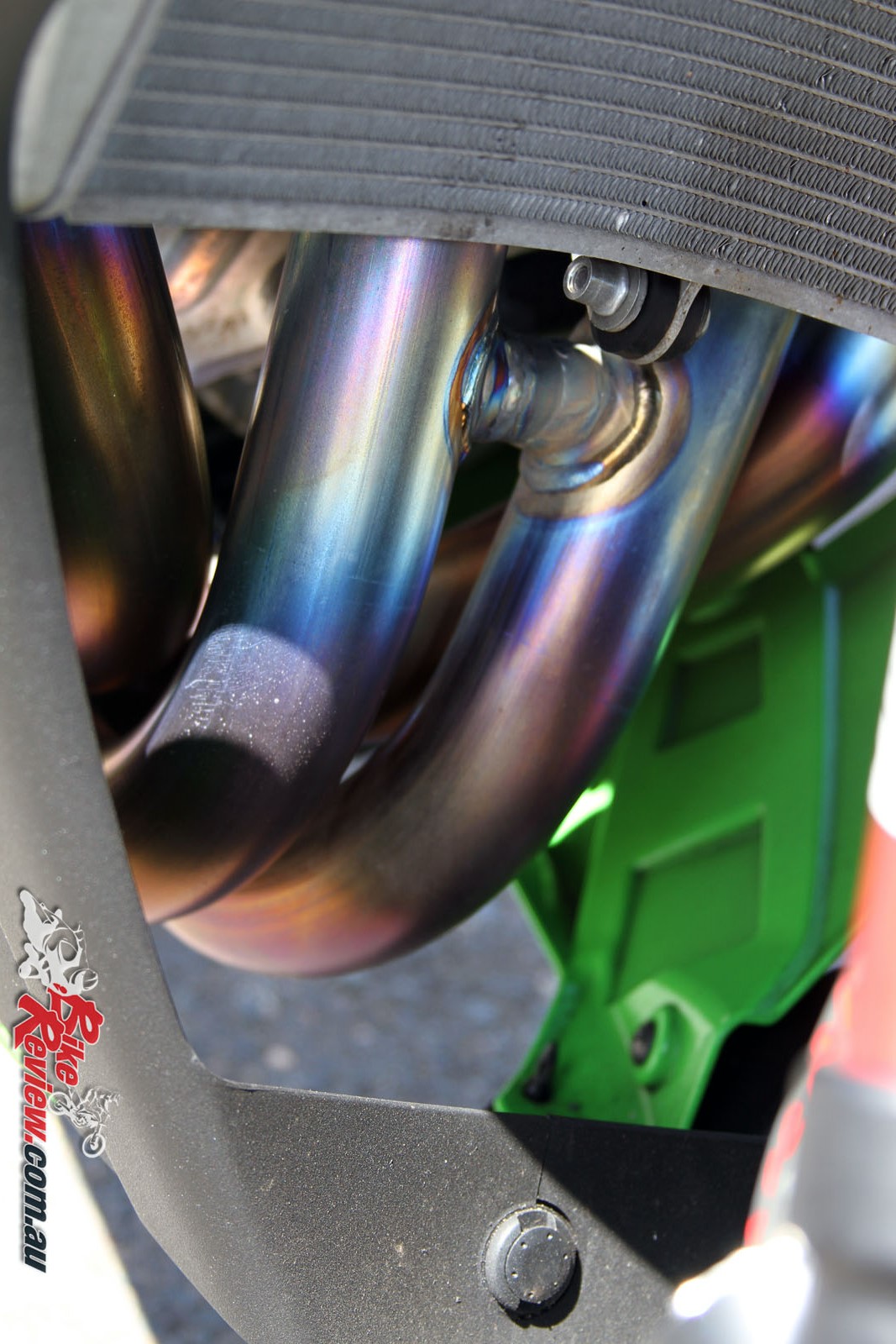
The headers and entire exhaust system including the muffler are all titanium, helping reduce weight and increase longevity.
The head pipe is moved 7.5mm closer to the rider to place more weight on the front, giving more front-end feel and increased stability and confidence on corner entry, also helping with direction changes and braking. The reverse offset collars in the race kit allow adjustment 4mm either way from standard, while other collars allow head angle changes. The swingarm pivot point can also be adjusted via the race kit parts.
The swingarm’s optimised torsional rigidity contributes to the bike’s nimbler handling and is 15.8mm longer, contributing to the increased front weight bias and increasing traction on corner exit.
A larger upper cowl improves the aero performance of the bike-rider package, increases wind protection and enables the rider to move more easily setting up for a corner. The screen is fully supported by the upper cowl now, and has wind inlets to stop negative cockpit pressure and helmet buffeting. The front guard is redesigned to direct more air to the radiator.
The 43mm Balance Free Forks bring SBK technology to the streets. Showa and Kawasaki developed the forks after Yoshimoto Matsuda approached Showa and convinced them to produce a race-spec mass-produced suspension system using their data from the Kawasaki SBK effort.
The high spec forks offer numerous benefits such as increased ride comfort, increased braking stability, increased front-end feel, independently adjustable compression and rebound circuits.
Damping force is generated outside of the main tube in the damping force chamber, which allows the piston in the main tube to act as a pump, pushing oil towards the valves. This helps reduce pressure balance fluctuations, which can cause cavitations, as a result of compression and extension. The external compression chamber is pressurised with nitrogen gas enabling very stable pressure increases. The compression and rebound circuits are completely independent from each other, giving smooth, optimal oil flows.
The Showa Balance Free Rear Cushion shock is a lighter and more compact version of the previous unit. Like the forks, the damping force is generated in an external chamber and compression and rebound are independent circuits. The position of the shock also minimises heat transfer from the engine or exhaust, giving more stable damping.
The brake system is all-new. Brembo M50 monoblock radial-mount calipers are used. They squeeze huge 330mm Brembo semi-floating rotors and a Brembo master-cylinder and reservoir that gets special attention before being shipped to Kawasaki. Each unit is tested and adjusted to eliminate any idle stroke in lever pull, to optimise initial braking. Full factory style… Stainless-steel lines complete the braking system.
2016 Kawasaki Ninja ZX-10R Engine
All new in 2011, the ZX-10R engine was designed to promote early throttle opening and drive by moving torque higher in the rev range. The new engine retains this character but offers a stronger mid-range and is more responsive, spinning up quicker thanks to a lower moment of inertia, which benefits accelerations and deceleration (along with cornering performance).
The feedback came from the SBK team. The intake ports are machined in two stages, first at the valve seats, then at an inclined angle, to promote a straight path for the air. The ports allow a greater volume on fuel-air mixture, increasing power, and are polished as well. The exhaust ports are also straighter and wider as well as polished, while the combustion chamber is reshaped and has larger 25.5mm EX valves up from 24.5mm. IN valve diameter is 31mm as per 2011 engine. Both IN and EX valves are now Ti.
Larger coolant passages in the head were made possible by the use of long reach spark plugs, vastly increasing performance. The spark plugs have platinum tips, contributing to linear power deliver particularly on initial throttle opening. They also have a very long service life.
Revised camshaft profiles give greater overlap and more power at high rpm and are now made of chromoly to reduce weight. A half nut cam chain tensioner helps with more stable valve timing.
The combustion chamber is dome machined and shorter pistons (39.2mm – 37.7mm) are employed with revised crowns. Each piston is 5g lighter, contributing to throttle response. The pistons are made from a new heat resistant alloy and have dry film lubricant coating on the skirts.
The crankshaft has a 20 per cent lower moment of inertia, the most significant change brought about through SBK feedback. Acceleration, deceleration and cornering all benefit. Engine response is improved while a single-shaft secondary balancer helps reduce engine vibration and also helps reduce the weight of the handlebar weights, aiding steering response marginally.
The big-end bearings are a new material reducing seizure risk, while the 2mm offset cylinders have 1mm thicker walls. The stacked gearbox shaft layout results in a high centre of gravity, while the cylinders bores are machined with a dummy head bolted on, yielding high bore circularity and cylindricity. As a result, low-tension piston rings are used, decreasing drag. The offset bore (2mm toward the exhaust side relative to the crank centre) reduces lateral piston force at the point of maximum combustion pressure, lowering piston loads and allowing the lighter pistons.
The cassette-style gearbox ratios are revised for track riding, with shorter ratios for second through sixth gears, aiding acceleration and more stable downshifting. A thinner clutch primary gear is 200g lighter, while fine-tuned primary ratios minimise rear end squat and lift on acceleration or during deceleration. The exhaust header pipes are made from special heat resistant Titanium and have the same diameter and lengths as the race-use system. The muffler is also Titanium.
The airbox is 2L larger now at 10L, while the aircleaner is 1.6 times larger in area. Revised intake funnels match the new engine, with the shape changing from oval to round to match the throttle-bodies. The throttle-bodies are 47mm items and feature dual injectors per cylinder, the secondary for top end rpm and the primary operating at all times. The fly-by-wire system allows full ECU control of the throttle valves, controlling fuel, air and engine braking.
YOSHIMOTO MATSUDA
Yoshimoto Matsuda is the Project Leader of the new ZX-10R and was in attendance for the test, held on a rural racetrack 120 miles form Sydney, Australia.
In 2002 Matsuda-San he was appointed engine designer for the Kawasaki 990 MotoGP project. The bike debuted in late 2002 and continued development through to 2009. Matsuda designed almost every aspect of the 800 version including the engine and chassis. Since then, Matsuda has been heavily involved in the Ninja series and with World Superbike and Supersport racing. This experience has led him to take the development of the ZX-10R to the next level as Project Manager of the 2016 model.
He had a chat to us explaining the thinking behind the ZX-10R.
Yoshimoto Matsuda, “When I was given the task of Project Leader for the new Ninja ZX-10R, I knew immediately we needed one goal, to be the fastest on track. Every change and improvement had to reflect lap times and all development needed to be done on the racetrack. I knew if I built a good bike on track, it would be good on the road. At the end of the development, we allowed test riders on the street. Their feedback indicated the bike is very good on the road. Many were surprised. I was not!
“First of all I needed to take advantage of the SBK rules to make our bike even more competitive. With feedback from Tom Sykes and Jonny Rea we were able to focus on the areas most critical – power delivery allowing early throttle opening, nimble handling, less crankshaft mass for lower inertia and therefore more control into corners and better acceleration.
“I also wanted to give the public and racers a true race replica. The ZX-10R has the same chassis, suspension and brakes as a top racer. It is not out of reach cost-wise like a de-tuned MotoGP bike. This is the real thing. If you want to race, fit a muffler and link pipe and go racing.
“No money was spent on cosmetic upgrades, not even a new dash, for example. I spent all resources on lap times and performance.
“We spent where it counts – brakes, suspension, exhaust material, electronics. This is a pure sportsbike, however, by default is a very nice road bike. It is comfortable and will be very reliable. I think you can own this bike for 10-years with no trouble”…
2016 Kawasaki Ninja ZX-10R Second Opinion
For my first visit to Wakefield Park – a short, tight track, I was a little intimidated by the new ZX-10R. This was a superbike designed for racing and track domination and I’m a road rider who enjoys a track day but is happy eating the dust of the many race experienced journos at these launches.
Jumping on the bike, the ZX-10R is tall, but reach to the ground is easy and on the move tucking into the bike is natural, plus it’s seriously compact without feeling in any way cramped. I’m around the 180cm mark and it just felt perfect from about the third corner… and that’s on a track I’m totally unfamiliar with.
The engine remains a belter and is responsive, with great mid-range and a staggering top end. I was nearing the 10k rpm mark and seeing the tacho start to flash red but you’ve got an easy 4000rpm left, which is where that power turns rocketship.
Down low it’s extremely manageable though, meaning you’re comfortable letting those revs drop if you don’t want to carry a heap of speed into the corner and while the bike will get a little lazy in picking those revs up again if you let them fall too low, it’s all very controlled and doesn’t unsettle the bike. Just what you want on the road where you’re never sure what’s around the next corner.
What helps highlight the engine is the fact the chassis changes, including a longer swingarm, lighter wheels, all new suspension and revised headstock – all turn the ZX-10R into an agile, neutral handling machine. Where the old machine would squat in the rear and loved a flowing line this new ZX-10R takes all that front end feel and confidence, increases it, adds a ton of agility and flickability, and has a much better supported rear end to boot.
It’s a really balanced machine and provides plenty of feedback to the rider while input is equally easily applied, to ensure you’re going where you want. The new Brembo M50 calipers with high end braided lines and Brembo master-cylinder also suggest how serious Kawasaki are getting and they’ve again done a great job in ensuring the brakes just work exceptionally well. They aren’t over sensitive or boasting too much bite, they are just balanced and well paired with the new front forks.
On the tight track washing off speed was easy and predictable with your concentration left on picking up your braking and turn in markers, at least for someone of my riding ability!
That’s what really impressed me, this is a bike that Kawasaki are openly stating is for the track and racing – no compromises, but I can jump on and feel at home, confident and happy to push the boundaries a bit to see how the bike reacts. Which was with great manners that said, “Yep, you’re just scratching the surface – I can go as far as you’re willing to take me.”
And that’s not even taking advantage of the massive plethora of electronics which are sure to increase safety on the road in any number of conditions, plus the nifty standard quick shifter. The 2016 ZX-10R is a bike which has seen a noticeable price increase but that’s because it’s competing with the top dogs with all the bells and whistles and by the looks of it, is going to be shaking up the category when the competition has never been fiercer.
2016 Kawasaki ZX-10R (ABS) Specifications
PRICE: $TBC+ ORC
WARRANTY: Two-year, unlimited kilometer
COLOURS: Lime Green KRT Edition, Metallic Matte Carbon Gray,
CLAIMED POWER: 147.1kW[200hp]@13000rpm
CLAIMED TORQUE: 113.5Nm[83.8ft-lbs]11500rpm
WET WEIGHT: 204kg
FUEL CAPACITY: 17L
ENGINE: Liquid-cooled, in-line four-cylinder, four-stroke, 16-valve, DOHC, 998cc, 13.0:1 compression, 76 x 55mm bore x stroke, four dual injection 47mm injectors, electronic throttle valves, S-KTRC, Ride Modes, KEBC, KLCM, KQS
GEARBOX: Six speed, cassette style
CLUTCH: Wet, multi-disc back-torque limiting clutch
CHASSIS: Cast aluminium twin spar frame, aluminium swingarm, Rake: 25, Trail: 107mm
SUSPENSION: 43mm Showa BFF fork, external compression chamber, compression, rebound, preload adjustable, Showa BFRC lite shock, compression, rebound, preload adjustable, horizontal Back-link
BRAKES: (KIBS) Dual 330mm semi-floating Brembo front rotors, Brembo radial Monobloc four-piston M50 calipers, Brembo master-cylinder, 220mm rear rotor, Nissin single-bore pin-slide caliper
Wheels & Tyres: Three-spoke cast aluminium, 120/70 – 17 58W, 190/55 – 17 75W
DIMENSION:
Wheelbase: 1440mm
Seat height: 835mm
Overall length: 2090mm
Overall width: 740mm
INSTRUMENTS: Digital multifunction display




